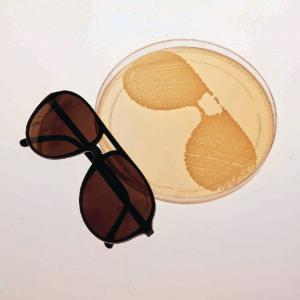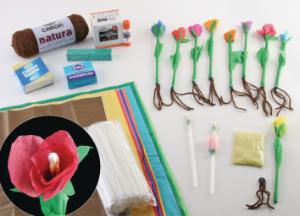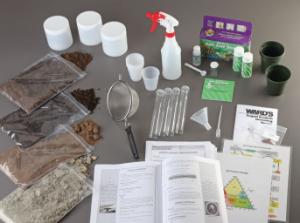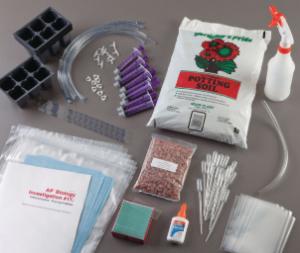Think outside the box with these outdoor science activities
All grades
Not all classrooms have four walls. As the weather warms up, encourage your students to head outside to convert their backyard into an outdoor science lab. From leaf chromatography to a microorganism-filled compost pile, these activities will help the science enthusiasts in your classroom explore the world outside their front door. Not to mention, the fresh air and muddy boots are sure to cure even the worst cases of cabin fever.
So, think outside the box and add some of these activities to your lesson plan.
- Creature features
- There's no monotony in the world of botany
- Atmospheric and solar zone
- Get the dirt on gardening
Creature features
Bug Blitz – As Study in Bio-Diversity, T. Tomm, Havana Junior High, Havana, IL
The goal of the project is to investigate biodiversity by documenting the bug populations that could be found in an outdoor space. Download the Bug Blitz Project Information file (includes links to the PPT and worksheets as well as information regarding learning standards.)
What Foods Attract Ants, TeacherVision
Students learn about ants and how they can locate food with this hands-on science activity. Students monitor how ants respond to different household foods. Don't worry, the experiment is not conducted inside the kitchen (much to Mom's relief), but outside in a corner of the yard or other outdoor space.
Good news: In response to these unprecedented challenges, TeacherVision is making all their resources freely available to teachers and parents.
Spider Science: Exploring the World of Webs, Education.com
How do spiders make their webs? If you had to build a web like a spider, how big would it be? Do you know what happens when an insect gets trapped in a spider's web? Guessing and testing are what real scientists do every day in the field – your students will, too, with this activity!
Bonus Material: Kids Guide to Beneficial Bugs for the Garden
Get this resource from the Plant a Seed and See What Grows Foundation.
There's no monotony in the world of botany
Colored Carnations, Kidzone
What in tarnation is up with these carnations! Use cut flowers to explore venation in plants (xylem) by putting cut flowers in colored water using food coloring. Use undiluted food coloring for faster, more impressive results. Petals end up with pretty, colored veins. Get creative by splitting the stem lengthwise and dipping the two sides in different colored solutions.
Leaf Transpiration, Kids Fun Science
The objective of this activity is to demonstrate transpiration by capturing the water that evaporates through leaves. Students use simple household materials to observe the process by which moisture is carried through plants from roots, then capillary action through the stem, and to small pores on the underside of leaves, where it changes to vapor and is released to the atmosphere.
Leaf Chromatography Experiment, The Homeschool Scientist
This simple experiment can be used to see all the beautiful pigments leaves possess any time of year. Students may be familiar with how chlorophyll gives leaves their green color and is essential for photosynthesis. This colorful experiment demonstrates the presence of other leaf pigments like carotenoids and anthocyanins.
Bonus Material: Download these resources from the Plant a Seed and See What Grows Foundation.
Plant a Seed and See What Grows –Ages 5-7
Plant a Seed and See What Grows –Ages 7-9
Atmospheric and solar zone
Make a UV Detector, Science Friday
In this activity, your students will use tonic water to detect ultraviolet (UV) light from the Sun. You can also get the DIY Sun Science app free, which allows families and educators to investigate and learn about the Sun at home or school! The app provides 13 free, easy to use, hands-on activities, plus images, videos, including live images of the Sun from NASA! Each activity includes material lists, step-by-step instructions, and detailed explanations.
Cloud in a Bottle, Science World
In this demonstration, students directly observe a cloud form right before their eyes. Cloud formation is part of the water cycle, but one we usually cannot see up close. Students will see how water in the atmosphere can be made visible by changes in pressure and temperature.
Making Sun S'mores, NASA Climate Kids
Harness the energy of the Sun to make the best snack ever invented. Yum! A solar oven is a box that traps some of the Sun's energy to make the air inside the box hotter than the air outside the box. In other words, the solar oven is like a super greenhouse.
Bonus Material: Sun Prints, the Small Science Club
Expand the UV Detector Lesson with this cool activity.
Get the dirt on gardening
Soil is Alive, Kids Gardening
Healthy soils are teeming with life, from microscopic bacteria and fungi to large mammals like moles and voles. In this lesson, students will explore the many organisms that call soil home. A lack of understanding about the complexities and importance of the soil food web results in problems for many gardeners.
Experiment with Composting and Learn About Food Waste, Clearway Community Solar
During the composting process, different microorganisms (bacteria, fungi, protozoa) decompose the organic matter. The microorganisms break down the organic food items to produce a simpler substance called compost. It's important to note that composting needs oxygen, heat, and water to be successful. These three elements help the microorganisms to multiply and survive. In this experiment, your students will add two of the main ingredients needed for composting.
Rain Gardens, Kids Gardening
Rain gardens help collect stormwater to reduce runoff, providing numerous environmental benefits. They are excellent tools for teaching students about the water cycle, stormwater drainage, water quality, and the broad environmental impacts of urbanization. This lesson provides instructions for designing your own rain garden. Grade Level/Range: 9 to 12.
Bonus Material: Digging into Soil: A Garden Practicum
A garden program to teach students about soil. Grades 9 -12 and the activities are linked to high school level NGSS. The lessons can be adapted for middle school ages too.
The activities shared here create opportunities for your students to study science principles by engaging their natural curiosity about the world around them. As always, encourage your students to use their science notebook to help them organize and keep track of their learning experience.
Recommended products:
[StartProductBlock]

Ward's® Effects of Solar UV Radiation on Cells Lab Activity
Do sunscreens and sunglasses really work to block damaging UV rays? Students can gauge the effects of the Sun on yeast cells, applying their findings to humans as well. Other experiments explore factors such as the angle of the Sun, ozone depletion, and air pollution.
[EndProductBlock]
[StartProductBlock]

Build a Flowering Plant Model: An Inquiry
Hands-on construction activity leads students through building their own colorful models of beautiful flowering plants, which will reinforce the structure and function of each part. Includes labeling a diagram and completing a chart of functions.
[EndProductBlock]
[StartProductBlock]

APES Lab #1: The Soil Factor: How Does Your Garden Grow?
Students examine the role of soil and soil dynamics in our environment in this comprehensive introduction to soil properties and classification methods. They explore soil texture, porosity, soil nutrients, soil moisture, and holding capacity, and the impact these factors have on growing plants.
[EndProductBlock]
[StartProductBlock]

Ward's® AP Biology Investigation 11: Interactions: Transpiration
Students explore factors that affect the rate of transpiration both in the short term of an experiment as well as within an evolutionary context. By analyzing stomata density in leaf types and constructing a simple potometer to determine rate of transpiration, students will discover how plants adapt to changing environments to regulate water loss and photosynthesis.
[EndProductBlock]
